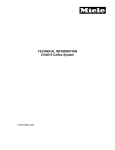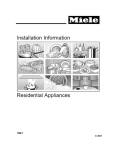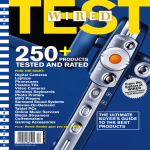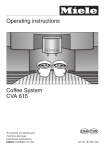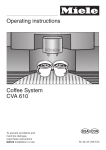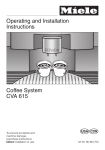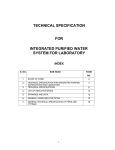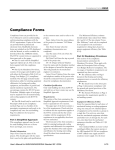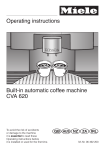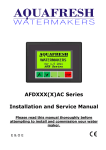Download Miele cva 610 Technical information
Transcript
TECHNICAL INFORMATION CVA610 Coffee System © 2004 Miele CVA610 Coffee System - Table of Contents 1.0 CONSTRUCTION & DESIGN 1.1 Appliance Overview 1 1.2 Technical Data 3 1.3 Layout of Components 5 2.0 INSTALLATION Installation Procedures 7 3.0 COMMISSION and OPERATION 3.1 General Operation 9 3.1.1 Preparing Coffee 9 3.1.2 Canceling the Preparation 10 3.1.3 Steam Control 10 3.1.4 Hot Water Dispensing 11 3.1.5 Adjusting the Coffee Grinder 12 3.1.6 Filling the Coffee Bean Container 13 3.1.7 Filling the Water Tank 14 4.0 DESCRIPTION of FUNCTION 4.1 Door Switch 15 4.2 Overflow Switch 15 4.3 Brew Unit – Home Position 16 4.4 Brew Unit – Drive & Water Connections 17 4.5 Brewing Procedure 18 4.6 Waste Unit 21 4.7 Waste Unit Present Switch 21 4.8 Water Tank 23 4.9 Water Level Switch 24 4.10 Grinder Assembly 25 4.11Grinder – Overload Protection 26 4.12 Ground Coffee – Dispensing 28 4.13 Brew Unit Drives 30 4.14 Water Pump 32 4.15 Flow meter 33 4.16 Heater – Data 33 4.17 Heaters 34 4.0 DESCRIPTION of FUNCTION (Continued) 4.18 Water Path 36 4.18.1 Water Intake 37 4.18.2 Water Path - Coffee 37 4.18.3 Water Path – Hot Water 37 4.18.4 Water Path - Steam 37 4.18.5 Steam Valve and Steam Valve Switch 37 4.19 Heater Outlet Valve (Nipple) 38 4.20 Electronic Assembly 39 5.0 SERVICE and MAINTENANCE 5.1 Lid – Removal 41 5.2 Mains Filter – Removal 41 5.3 Rear Panel – Removal 42 5.4 Adjustment Slide Switch Frame - Removal 43 5.5 Door Contact Switch - Removal 44 5.6 Base Plate - Removal 45 5.7 Drip Tray - Removal 46 5.8 Overflow Switch Actuator Float - Removal 47 5.9 Overflow Switch - Removal 48 5.10 Fluorescent Lamp – Removal 49 5.11 Lamp Starter - Removal 49 5.12 Rear Door Panel – Removal 50 5.13 Fascia Panel Cover – Replacement 51 5.14 Selector Switch - Removal 52 5.15 Display Module Electronic – Removal 53 5.16 Coffee Dispensing Nozzle – Removal 54 5.17 Coffee Dispensing Nozzle - Fitting 55 5.18 Steam Valve and Steam Valve Switch - Removal 56 5.19 Hot Water Nozzle - Removal 57 5.20 Hot Water Nozzle - Removal 58 5.21 Coffee Temperature - Check 58 5.22 Brew Unit – Removal (in start/home position) 58 5.23 Brew Unit – Removal (NOT in start//home position) 59 5.24 Brew Unit – Installation 61 5.25 Brew Unit – Cleaning Procedure 61 5.0 SERVICE and MAINTENANCE (Continued) 5.26 Brew Unit – Filter Cleaning 62 5.27 Brew Unit – Degreasing via the Rinse Cycle 63 5.28 Brew Unit – Lubrication 65 5.29 Brew Unit – Manual Reset to “Home Position” (Brew Unit Not Installed) 66 5.30 Brew Unit Creamer Valve – Removal 67 5.31 Brew Unit Handle – Removal 67 5.32 Brew Unit Funnel – Removal 68 5.33 Brew Unit Ram – Service 69 5.34 Water Tank Level Indicator Float – Removal 71 5.35 Water Tank Sealing Ring – Removal 72 5.36 Lower Section of Tank Valve – Removal 73 5.37 Bean Container – Removal 75 5.38 Bean Container Guide – Removal 76 5.39 Grinder Unit – Disassembly 77 5.40 Grinder Unit – Assembly & Basic Setting 80 5.41 Grinder Unit – Removal 81 5.42 Brew Unit Present Switch – Removal 83 5.43 Dispensing Solenoid – Removal 83 5.44 Dispenser Switch – Removal 83 5.45 Brew Unit Drives – Home Positioning 84 5.46 Waterpath / Flowmeter Check 84 5.47 Waterpath Leakage Test 85 5.48 Water Connections – Releasing 86 5.49 Water Connections – Fitting 87 6.0 FAULT DIAGNOSIS 6.1 Programming Mode 89 6.2 Service Mode 90 6.3 Displayed Messages 92 6.4 Uneven Filling 94 6.5 Brew Unit – Can’t be removed from appliance 94 6.6 Brew Unit – Can’t be installed 94 6.7Grinder Setting – Can’t be set to finer position 95 CVA610 Coffee System – List of Figures 1-1 Appliance Overview (Exterior) 1 1-2 Appliance Overview (Interior) 2 1-3 Product Dimensions 3 1-4 Overview of Components 5 2-1 Installation Information 7 3-1 Coffee cup placed under both dispensers 9 3-2 Pressing the Coffee Button 9 3-3 Displayed Message During Dispensing 9 3-4 Canceling the preparation 10 3-5 Steam Control 10 3-6 Cup placed under hot water dispenser 11 3-7 Hot Water Button 11 3-8 Grinder Adjustment Control 12 3-9 Filling the Coffee Bean Container 13 4-1 Door Contact Switch 15 4-2 Brew Unit in home position 16 4-3 Brew Unit drive connections 17 4-4 Brew Unit Filters 18 4-5 Brew Unit Components 19 4-6 Brew Unit releasing a “puck” 20 4-7 Waste Unit Present Switch 21 4-8 Waste Unit Magnet 22 4-9 Water Tank Valve 23 4-10 Water Level Switch 24 4-11 Water Level Switch Float 24 4-12 Grinder Assembly 25 4-13 Grinder Overload Protection Components 26 4-14 Grinder Cone Ball Positions 27 4-15 Coffee Dispensing Components 28 4-16 Dispensing Lever 29 4-17 Brew Unit Drive Components 30 4-18 Brew Unit Drive Assembly 31 4-19 Water Pump 32 4-20 Hot Water / Coffee Heater 34 4-21 Steam Heater 35 4-22 Water Path 36 4-23 Heater Drainage Nipple 38 CVA610 Coffee System – List of Figures (Continued) 4-24 Electronic Board (Layout) 39 5-1 Lid and Securing Screws 41 5-2 Mains Filter Mounting 41 5-3 Rear Panel – Removal 42 5-4 Removing the Slide Switch Frame 43 5-5 Door Switch 44 5-6 Base Plate Removal 45 5-7 Drip Tray 46 5-8 Overflow Switch Float 47 5-9 Overflow Switch 48 5-10 Fluorescent Lamp Access and Removal 49 5-11 Starter Removal 49 5-12 Rear Door Panel – Removal 50 5-13 Fascia Panel Cover Assembly 51 5-14 Selector Switch 52 5-15 Rear View of Front Door w/ Panel Removed 53 5-16 Coffee Dispensing Components 54 5-17 Steam Valve and Steam Valve Switch 56 5-18 Hot Water Valve 57 5-19 Brew Unit Connection Socket 60 5-20 Brew Unit Connection Socket Retaining 60 5-21 Brew Unit Removal 61 5-22 Brew Unit Installation 62 5-23 Cleaning Tablet being placed into brew unit 63 5-24 Brew Unit – lubrication points (1) 65 5-25 Brew Unit – lubrication points (2) 65 5-26 Moving the Brew Unit to the home position 66 5-27 Brew Unit in reset position 66 5-28 Brew Unit (output and retaining lugs) 67 5-29 Rear of Brew Unit 68 5-30 Front of Brew Unit 68 5-31 Brew Unit Ram 69 5-32 Brew Unit Chamber 70 5-33 Brew Unit Ram and Filter Removed 70 5-34 Removing cap to tank float 71 5-35 Levering off the Lip Seal Cap 72 5-36 Removing the Lip Seal 72 5-37 Water Tank Lip Seal – Removal 73 CVA610 Coffee System – List of Figures (Continued) 5-38 Underside view of the CVA610 74 5-39 Removing the Bean Container 75 5-40 Removing the Beans Container Guide 76 5-41 Accessing the Grinder 77 5-42 Upper section of the Grinder 78 5-43 Grinder 79 5-44 Grinder Removal 81 5-45 Grinder Coupling 82 5-46 Brew Unit Present Switch 83 5-47 Water System Connection 86 CVA610 Coffee System – List of Tables 5-1 Programming Mode 89 5-2 Service Mode Navigation 91 5-3 Displayed Messages (part 1 of 2) 92 5-4 Displayed Messages (part 2 of 2) 93 CVA610 Coffee System Technical Information 1.0 Construction and Design 1.1 Appliance Overview Figure 1-1: Appliance Overview (Front & Controls) 1 CVA610 Coffee System Technical Information Figure 1-2: Appliance Overview (Interior) 2 CVA610 Coffee System Technical Information 1.2 Technical Data Figure 1-3: CVA610 Product Dimensions Electrical Information The CVA610 Coffee System is equipped with a power cord and a molded NEMA 6-15P plug for connection to a 240 (208) V, 15 A, 60 Hz NEMA 6-15R (receptacle). 3 CVA610 Coffee System Technical Information 4 CVA610 Coffee System Technical Information 1.3 Layout of Components 1 2 3 4 5 6 7 8 9 10 11 12 13 14 Steam Valve Switch Door Magnet Fluorescent Bulb Starter Control Panel / Electronic Selector Switch Thermostat PTC Temperature Sensor Heater (Coffee & Water) Heater (Steam) Thermostat PTC Temperature Sensor Steam Solenoid Dispenser Solenoid 15 Dispenser Switch 16 17 18 19 20 21 22 23 24 25 26 27 28 29 30 31 Figure 1-4: Overview of Components 5 Terminal Block Flowmeter Interference Capacitor Electronic Board Door Interlock Switch Water Pump Grinder Drive Motor Brew Unit Present Switch Water Tank Level Switch Brew Unit Home Switch Overflow Float Switch Brew Unit Brew Position Switch Waste Unit Present Switch Hot Water Valve Lamp Ballast CVA610 Coffee System Technical Information 6 CVA610 Coffee System Technical Information 2.0 Installation Figure 2-1: Installation Information Note For further information, refer to the installation section of the Operating Manual -OR- the Miele installation Manual. 7 CVA610 Coffee System Technical Information 8 CVA610 Coffee System Technical Information 3. Commission and Operation 3.1 General Operation 3.1.1 Preparing Coffee 1. Place a cup under both coffee dispensers. Figure 3-1: Coffee cup placed under both dispensers. 2. Press the desired coffee button once. Figure 3-2: Pressing the coffee button The coffee will be prepared. The following message will appear in the message window, depending on the button pressed: Figure 3-3: Displayed Message While Dispensing 9 CVA610 Coffee System Technical Information 3.1.2 Canceling the Preparation Press one of the coffee buttons to stop preparation immediately. Figure 3-4: Canceling the preparation 3.1.3 Steam Control ● Turn the steam ON by turning the steam selector counterclockwise. ● Turn the steam OFF by turning the steam selector clockwise. Figure 3-5: Steam Control 10 CVA610 Coffee System Technical Information 3.1.4 Hot Water Dispensing 1. Place a cup under the hot water dispenser. Figure 3-6: Cup placed under hot water dispenser 2. Press the hot water button. Hot water will be dispensed. 3. Press the hot water button again to stop the hot water flow. Figure 3-7: Hot water button Service Tip The hot water dispensing stops automatically if… a specific volume (cup size) is programmed and the "Programmed Hot Water" feature is activated. 11 CVA610 Coffee System Technical Information 3.1.5 Adjusting the Coffee Grinder Controls: to the left for finer grinding to the right for coarser grinding. Figure 3-8 Grinder Adjustment Controls If the coffee flows too quickly, the beans have been ground too coarsely. Adjust the grinder to a finer setting. If the coffee trickles, the beans have been ground too finer. Adjust the grinder to a coarser setting. Note You should be able to feel the notches when moving the slide control. If the slide control will not move: Close the machine and dispense a cup of coffee. Then try to move the slide control again. 12 CVA610 Coffee System Technical Information 3.1.6 Filling the Coffee Bean Container 1. Carefully pull the container outward until the lid is visible. 2. Lift the lid (as shown in figure 3-9. 3. Fill the container with coffee beans to about 1" from the top. 4. Close the lid and push the container back into place. 5. Shut the appliance door. Figure 3-9 Filling the Coffee Bean Container Important Only put pure espresso or coffee bean in the container. Anything else, including ground coffee, hot cocoa, instant coffee, or treated coffee beans (flavorings, caramel, or sugar) will damage the grinder. Service Tip Always remove all coffee beans before attempting to remove the bean container. Failure to do so will result in the beans spilling out! Refer to 5.37 for additional information. 13 CVA610 Coffee System Technical Information 3.1.7 Filling the Water Tank The Water Tank must be cleaned and filled with fresh water before each day of use. A reminder will appear in the message window when the unit is first turned on. 1. Open the front of the machine. 2. Lift the water tank up and out of the appliance. 3. Open the lid and fill the container with cold drinking water to within about 1" (2 cm) of the top. Important Never add hot water or any other liquids to the water tank. 4. Close the lid and place the tank in the machine, pushing it straight back. Ensure the tank is fully seated into position. 14 CVA610 Coffee System Technical Information 4.0 Description of Function 4.1 Door Switch (S24) The Door Switch interrupts the main power circuit when the door is opened. Figure 4-1: Door Contact Switch (S24) 4.2 Overflow Switch (B8/3) The Overflow Switch is mounted to the bottom of the casing. The associated float (with internal magnet) is located within the drip tray. Should a leak develop, water flows into the drip tray. The float rises and the Overflow Switch becomes actuated. The electronic then displays the “Watersystem Fault” message. 15 CVA610 Coffee System Technical Information 4.3 Brew Unit – Home Position Refer to figure 4-2. The brew unit must be in the “home position” before it can be removed from the appliance. Fig. 4-2: Brew Unit in the “home” position 16 CVA610 Coffee System Technical Information 4.4 Brew Unit – Drive and Water Connections Refer to figure 4-3. When the Brew Unit is installed, it locks into position. The Locking Mechanism Switch Lug (item 3), activates the Brew Unit Present Switch (item 4). The Drive Shaft (item 6), engages with the Drive Shaft Socket (item 1) to provide drive to the Brew Unit. When the Brew Unit moves into the “Brewing Position” the Hot Water / Water Connection Socket (item 2) connects to the Nozzle on the Hot Water / Coffee Heater (item 5). 1 Drive Shaft Socket 2 Water Connection Socket 3 Locking Mechanism Switch Lug 4 Brew Unit Present Switch 5 Water Nozzle 6 Drive shaft Figure 4-3: Brew Unit drive connections 17 CVA610 Coffee System Technical Information 4.5 Brewing Procedure 1. The output of the Grinder provides ground coffee to the Dispenser Housing; until it filled (as determined by the dispenser switch). 2. The Grinder is then powered by off by the Electronic. 3. The Dispenser Flap opens twice (two clicks can be heard) via the Dispenser Solenoid. 4. The ground coffee falls into the Brew Unit (via the funnel). 1 Funnel 2 Percolator chamber 3 Bottom filter Figure 4-4: Brew Unit Filters 18 CVA610 Coffee System Technical Information Refer to figure 4-5 5. The Brew Unit Drives move the Brew Unit into the “Brewing Position” (as determined by the Brew Position Switch). The grounds are compressed between the top filter (item 2) and bottom filter (item 5). 6. The Water Pump is energized to pump the water through the Hot Water / Coffee Nozzle and into the Brew Unit via the Water Connection Socket (item 4). The hot water forces through the brew unit and the compressed grounds (Pos 3) and exits the top of brew unit via the drain spout (item 1). With the door of the appliance closed, the drain spout makes contact with the dispensing system on the front of the appliance. The users cup is filled with coffee, as the coffee flow exits. 1 Percolator Outlet 2 Top Filter 3 Compressed Coffee 4 Water Connection Socket 5 Bottom Filter Figure 4-5: Brew Unit components. 19 CVA610 Coffee System Technical Information Refer to figure 4-6… 7. The drives are energized (in reverse) and move the Brew Unit toward the “home position” position. As this action occurs the coffee chamber moves upward and releases the used compressed coffee grounds. (item1). 8. The drives continue, returning the Brew Unit to the “home position” (as determined by the Home Position Switch. Figure 4-6: Brew Unit, showing compressed coffee “puck”. 20 CVA610 Coffee System Technical Information 4.6 Waste Unit After coffee has been prepared, the compressed coffee grounds “puck” falls into the Waste Unit. The electronic monitors the number of the compressed “pucks”, until a specific value is reached. The electronic then displays the “Empty Waste Unit” message to the user. 4.7 Waste Unit Present Switch The Waste Unit Present Switch is mounted to the bottom of the CVA610 housing (behind the area of the Waste Unit) – as shown in the figure 4-7. Figure 4-7: Waste Unit Present Switch. 21 CVA610 Coffee System Technical Information The actuating magnet (Figure 4-8, item 1) for the Waste Unit Present Switch is located at the bottom edge of the Waste Unit. Figure 4-8: Waste Unit. (1) Magnet for Waste Unit Present Switch. Note On newer manufactured Waste Units, an additional magnet is present to keep the waste unit attached to the metal frame inside the appliance. The magnet for the Waste Unit Present Switch remains in the same location. 22 CVA610 Coffee System Technical Information 4.8 Water Tank Refer to the figure 4-9. The Water Tank holds the water for the coffee, hot water and steam. When the water tank is fitted in position, the sealing ring presses upward so water cannot leak. Figure 4-9: Water Tank (1) Valve Assembly. When the Water Tank is removed from the appliance; a spring forces the sealing ring into a position so water cannot flow from the tank. 23 CVA610 Coffee System Technical Information 4.9 Water Level Switch The Water Level Switch is located within the housing, in the area behind the Water Tank Cavity (as shown in figure 4-10). Figure 4-10: Water Level Switch The Actuating Magnet for the Water Level Switch is located within the float. The float is then installed into the Water Tank (as shown in figure 11, item 1). Figure 4-11: Water Level Switch Float With the Water Tank installed and containing at least 900-1000 milliliters of water, the Water Level Switch contacts are closed. When the water level drops below the minimum quantity, the Water Level Switch contacts open. At this time the quantity incoming water is monitored by the Electronic (via the flowmeter). Once 800 milliliters of water is measured, the “Fill Water Tank” message is displayed. 24 CVA610 Coffee System Technical Information 4.10 Grinder Assembly Refer to figure 4-12. The grinding grade depends on the gap between the Grinding Cone (Item 1) and the Grinding Ring (Item 2). The gap is set via the Adjustment Lever, (Item 5) on the Adjustment Ring (Item 3). The smaller the gap, the finer the grind of coffee will be. 1 Grinding cone 2 Grinding ring 3 Adjustment ring 4 Intake worm gear 5 Adjustment lever 6 Handle Figure 4-12: Grinder Assembly Warning! To avoid binding the grinder, adjustments should be made in small steps. 25 CVA610 Coffee System Technical Information 4.11 Grinder - Overload Protection Should the grinder become blocked by a foreign object (i.e. stone / pebble), the slip coupling interrupts the drive between the motor and the grinder. Refer to figure 4-13… The Grinder Motor (item 1) drives the Mounting (item 3) via the Carriers (item 2). This rotary force transfers through the Balls, (item 5) to the Grinder Cone (Item 6). 1 Grinder motor 2 Carrier 3 Mounting 4 Spring 5 Ball 6 Grinding cone 7 Washer 8 Intake worm gear Figure 4-13: Components of the Grinder Overload Protection 26 CVA610 Coffee System Technical Information Should the grinder cone become blocked, the Balls get pressed into the Mounting (as shown below in figure 4-14, Item C) resulting in the drive force being interrupted. A Normal operation B Overload protection activated C Force transfer interrupted Figure 4-14: Grinder cone ball positions under various operating conditions. 27 CVA610 Coffee System Technical Information 4.12 Ground Coffee - Dispensing Refer to figure 4-15. By adjusting the Dispenser Lever (item 1), the position of the Dispensing Switch (item 2) is modified. The change results in change to the volume of the dispenser container; hence the quantity of ground coffee changes. Each position along the setting alters the coffee quantity by about 0.5 grams. The grinder fills the dispenser container with ground coffee. When the dispenser container is full, the Dispenser Switch is activates and the grinder motor is switched off. 1 Dispenser Lever 2 Dispensing Switch (1S13) 3 Catch - Switch - Dispensing 4 Catch - Coil - Dispensing 5 Coil - Dispensing (1L1) 6 Spring 7 Actuator 8 Bolt 9 Dispenser Flap 10 Wiper Figure 4-15: Coffee Dispensing Components 28 CVA610 Coffee System Technical Information Figure 4-16: Dispensing Lever The dispensing solenoid is activated twice by the electronic. During the initial activation the ground coffee drops into the brew unit. The second activation is to ensure no loose grounds block the channel, as the wiper passes and loosens any ground coffee residues. If the dispenser container is not filled (i.e. no coffee beans) the Dispenser Switch is not activated and the “Fill Coffee Beans” message is displayed. 29 CVA610 Coffee System Technical Information 4.13 Brew Unit Drives Refer to figure 4-17… The Brew Unit locks into position against the Drives Mounting Plate. The locking mechanism Switch Lug (Item 3) activates the Brew Unit Present Switch (Item 4). The Drive Shaft, (Item 6) engages with the Percolator Drive Shaft Socket, 1 Drive Shaft Socket 2 Socket 3 Locking Mechanism & Switch Lug 4 Brew Unit Present Switch 5 Coffee / Hot Water Heater Nozzle 6 Drive Shaft Figure 4-17: Components of the Brew Unit Drive Assembly. 30 CVA610 Coffee System Technical Information Refer to figure 5-18. The Drive Motor (Item 4) powers the Worm Gear (Item 3). The drive action is transferred to the Step-down Gear and then the Drive Gear. The center of the Drive Gear contains the Drive Shaft that connects to the Brew Unit Drive Shaft Socket. The drive gear The drive shaft cog wheel has two switch actuators, (Items 2 & 5) for the limit switches for the brew position and home position. The electronic unit registers the brew position and the home position via the limit switches, (Items 1 and 7). 1 2 3 4 5 6 7 Switch – home position switch Switch actuator – home position Bearing bush Brew unit drive motor Switch actuator – brew position Fitting marking Switch – brew position Figure 4-18: Brew Unit Drive Assembly 31 CVA610 Coffee System Technical Information 4.14 Water Pump The pump is self-priming and can develop a pressure of up to approx. 16 bar. For espresso preparation a pressure of approx. 8 bar is required so that the water can be forced through the compressed ground coffee. A further increase in pressure does not improve beverage quality. The pump is fitted with a safety valve which opens at 16 bar system pressure. If pressure is too high, water is passed from the safety valve via a hose to the fitting plate and from there to the housing under the percolator unit. The water is then passed through the door rear panel to the drip tray. The pump is connected in series with a temperature limiter. The temperature limiter switches off the pump if a high temperature is developed. Figure 4-19: Water Pump 32 CVA610 Coffee System Technical Information 4.15 Flow meter All water taken from the water container flows through the flow meter. The flow meter passes signals to the electronic unit proportional to the quantity of water passing through it. The electronic unit then establishes the quantity of water that has flowed and stores the figure. Approx. 300 pulses from the flow meter indicate a flow of 100 ml water. The electronic unit controls the required water quantity for beverage preparation and ensures that it remains constant. The service mode can be used to check the proper operation of the flow meter. 4.16 Heater - Data Coffee / Hot Water Heater 1R1 & 1R2 Voltage 220(240) V Power rating 1090 W / 437 W Steam Heater 2R1 Voltage 220(240) V Power rating 1100 W 33 CVA610 Coffee System Technical Information 4.17 Heaters Refer to the figure 4-20… The Coffee / Hot Water consist of a large heater element (Item 1) and a smaller heater element (item 7). The Steam Heater has consist of one heater element (figure 4-21, Item 3). Each Heater uses a temperature sensor (Item 5) that provides signals to the Electronic to monitor the temperature ; and control the cycling (switching) of the Heater Element(s). Additionally, each Heater assembly is equipped with a Temperature Monitor (Item 3) connected electrically in series with the element. Should the temperature become excessive, the device electrically interrupts the power to the heater element. 1 2 3 4 5 6 7 8 9 10 Heater element Connector Temperature monitor Temperature safety fuse PTC Temperature sensor Temperature safety fuse Heater element - Small Connector Mounting Outlet Figure 4-20: Hot Water / Coffee Heater (1R1 and 1R2) 34 CVA610 Coffee System Technical Information The heating circuit also contains a Temperature Activated Safety Fuse. Should the temperature exceed a specific threshold due to an operating fault, the fuse blows and interrupts power to the element(s). Should this fuse be blown, the cause must be located and resolved before replacing the fuse. 1 2 3 4 5 6 Temperature monitor (thermostat) Temperature safety fuse Heater element Connector - Pressure system to steam valve in door Connector - Pressure system from steam valve (solenoid valve) PTC Temperature sensor (2R30) Figure 4-21: Steam Heater (2R1) 35 CVA610 Coffee System Technical Information 4.18 Water Path 1 2 3 4 5 6 7 8 9 10 11 12 13 14 Water tank Sealing ring Water filter Flow meter Pump Valve - Safety Drain hose - Excess pressure Through-flow heater - Coffee Outlet to brew unit (nipple) Valve - Steam (solenoid valve) Valve - Hot water (solenoid valve) Through-flow heater - Steam Valve - Steam (in door) Frothing nozzle Figure 4-22: Water Path 36 CVA610 Coffee System Technical Information 4.18.1 Water Intake The Water Pump is responsible for taking in water from the Water Tank. The bottom of the pump contains a safety valve. The valve is designed to open should the system pressure exceed 16 bar (232 psi). A hose is connected to the valve to route the water away from the components. 4.18.2 Water Path - Coffee Water exiting the Water Pump is pumped under pressure through the Flowmeter, through the Coffee / Hot Water Heater and through the Heater Outlet Valve (Nipple) into the Brew Unit. Water passes through the compressed coffee grounds and exits the Brew Unit as coffee. The coffee then flows to the dispenser tubes on the front of the appliance into the user cup. 4.18.3 Water Path - Hot water Water exiting the Water Pump is pumped under pressure through the Flowmeter, through the Coffee Heater and through the Hot Water Valve and Hot Water Outlet. 4.18.4 Water Path - Steam Water flows the same as the hot water system, except the water exiting the Coffee / Hot Water Heater is routed via Steam Solenoid into the Steam Heater. Steam exits the Steam Heater and exits via the Steam Valve and Frothing Nozzle. 4.18.5 Steam Valve and Steam Valve Switch The Steam Valve is a mechanical valve regulated via a knob on the front of the appliance. As the knob is turned counterclockwise the amount of steam exiting the valve increases. The Steam Valve Switch is mounted to the Steam Valve Bracket. When the Steam Valve is opened, the Steam Valve Switch is actuated. The switch is monitored by the Electronic and when actuated, the Electronic energizes the Steam Solenoid (routing the exiting water from the Coffee / Hot Water to the Steam Heater). 37 CVA610 Coffee System Technical Information 4.19 Heater Outlet Valve (Nipple) The Heater Outlet Valve is normally closed. However, during the brewing process the Brew Unit is driven into the “Brew Position and mechanically opens valve. This allows the hot water (under pressure) to flow through the brew unit. The Heater Outlet Valve uses several o-rings to ensure the connection between the Outlet Valve and the Brew Unit remain air and water tight. This ensures air does not entering the water path and disrupt the proper flow and pressure; and water does leak from the system. Figure 4-23: Heater Drainage (Nipple) The two o-rings that form the seal to the brew unit can be accessed and replaced from the front / inside area of the appliance - once the brew unit removed. To access the upper seal or for service on the valve; the Heater Assembly must be removed from the appliance. This permits easy disassembly of the valve for a thorough inspection. Although components of the valve are available separately, it is highly recommended the three components be replaced at one time. 38 CVA610 Coffee System Technical Information 4.20 Electronic Assembly Figure 4-24: Preview of Electronic Board Assembly For further information on the electronic modes – refer to section 6 “Fault Diagnosis” 39 CVA610 Coffee System Technical Information 40 CVA610 Coffee System Technical Information 5.0 Service and Maintenance 5.1 Lid - Removal 1. Remove the lid screws, as shown in Figure 5-1 2. Remove the lid. Figure 5-1: Lid and securing screws 5.2 Mains Filter (Z1) - Removal 1. 2. 3. 4. Perform: Lid removal (5.1). Remove the mains filter nut (Figure 2 - Item 1). Remove the Filter. Disconnect the mains filter electrical connections Figure 5-2: Mains Filter (Z1) Mounting Location 41 CVA610 Coffee System Technical Information 5.3 Rear Panel - Removal 1. 2. 3. 4. 5. Remove the lid (5.1). Remove the Mains Filter (5.2). Remove the fixing screws from the rear panel. Disconnect the earth lead from the rear panel. Remove the rear panel upwards. Figure 5-3: Rear Panel Removal 42 CVA610 Coffee System Technical Information 5.4 Adjustment Slide Switch Frame - Removal 1. Open the door. 2. Pull off the slide switch knobs. 3. Press the retaining lugs inwards with a small screwdriver (Figure 5-4). 4. Remove the frame. Figure 5-4: Removing the Adjustment Slide Switch Frame (Bezel). 43 CVA610 Coffee System Technical Information 5.5 Door Contact Switch (S24) - Removal Refer to figure 5-5 below… 1. 2. 3. 4. 5. Remove the lid (5.1) Open the door. Disconnect the door switch connections. Press the switch retaining lugs inwards with a small screwdriver. Remove the door switch to the front. Figure 5-5: Door Switch (shown with appliance door in open position) 44 CVA610 Coffee System Technical Information 5.6 Base Plate - Removal 1. 2. 3. 4. 5. Remove the Lid, Mains and Rear Panel (5.1 to 5.3) Open the door. Remove the grounds container. Remove the water tank. Check if water is present in the drip tray with a finger through the opening under the water container. 6. If water is present, remove it via a suitable device / tool. 7. Remove the percolator unit. 8. Remove the coffee beans from their container. 9. Remove the base plate fixing screws. 10. Tilt the unit onto its rear. 11. Remove the base plate and disconnect its earth lead. Figure 5-6: Base Plate – Removal 45 CVA610 Coffee System Technical Information 5.7 Drip Tray - Removal 1. Remove the Lid, Mains and Rear Panel (5.1 to 5.3) 2. Remove the Base Plate (5.6) 3. Remove the drip tray. Figure 5-7: Drip Tray 46 CVA610 Coffee System Technical Information 5.8 Overflow Switch Actuator Float - Removal 1. Remove the Lid, Mains and Rear Panel (5.1 to 5.3) 2. Remove the Base Plate (5.6) Note The orientation of the float before removal – ensure it is re-installed in the same direction. 3. Remove the Float. Figure 5-8: Overflow Switch Float 47 CVA610 Coffee System Technical Information 5.9 Overflow Switch (B8/3) - Removal 1. 2. 3. 4. Remove the Lid, Mains and Rear Panel (5.1 to 5.3) Remove the overflow switch fixing screw (Figure 9 – Item 1). Remove the overflow switch. Disconnect the overflow switch connections from the electronic. Figure 5-9: Overflow Switch 48 CVA610 Coffee System Technical Information 5.10 Fluorescent Lamp - Removal Refer to the figure 5-10 below… 1. Open the door. 2. Unclip the cover and remove it. 3. Turn the lamp tube 90° in the direction to remove the lamp. Figure 5-10: Fluorescent Lamp Access and Removal. 5.11 Lamp Starter - Removal Refer to the figure 5-11 below… 1. Open the door. 2. Unclip the neon tube cover and remove it. 3. Turn the starter in the direction of the arrow. 4. Remove the starter. Figure 5-11: Starter Removal 49 CVA610 Coffee System Technical Information 5.12 Rear Door Panel - Removal Refer to figure 5-12. 1. Open the door. 2. Remove the upper rear panel fixing screws (Item 1). 3. Remove the lower rear panel fixing screws (Item 2). Figure 5-12: Rear Door Panel – Removal. 50 CVA610 Coffee System Technical Information 5.13 Fascia Panel Cover – Removal 1. Open the door. 2. Remove the Rear Door Panel (5.12). 3. Remove the cover fixing screws (Figure 12 – Item 3). 4. Remove the cover. 1 Fascia 2 Cable guide 3 Fixing screws 4 Cover 5 Magnet 6 Cable guide Figure 5-13: Fascia Panel Cover Assembly 51 CVA610 Coffee System Technical Information 5.14 Selector Switch - Removal Refer to figure 5-14. 1. Open the door. 2. Remove the Rear Door Panel and Fascia Panel Cover (5.12 & 5.13). 3. Disconnect the connections from the selector switch, 4. Remove the switch knob (Item 9). 5. Remove the selector switch with its housing from the fascia. 6. Remove the selector switch fixing screws. 7. Remove the selector switch from its housing. Figure 5-14: Selector Switch 52 CVA610 Coffee System Technical Information 5.15 Display Module Electronic - Removal Refer to figure 5-15. 1. Open the door. 2. Remove the Rear Door Panel and Fascia Panel Cover (5.12 & 5.13). 3. Pull off the pushbutton knobs (Item 1). 4. Disconnect the connections from the electronic (Item 7). 5. Remove the electronic unit fixing screws (Item 6). 6. Remove the electronic unit. 7. Remove the display module fixing screws (Item 3). 1 2 3 4 5 6 7 Pushbuttons Display module, Display module fixing screws Display module and electronic unit connection Control and power modules connection Electronic unit fixing screws Electronic unit Figure 5-15: Rear View of Front Door with Rear Panel Removed. 53 CVA610 Coffee System Technical Information 5.16 Coffee Dispensing Nozzle - Removal Refer to Figure 5-16. 1. Open the door. 2. Remove the grille and drip tray from the door. 3. Remove the fixing screws from the white panel under and behind the nozzle. 4. Remove the white panel. Note The two fixing screws for the moveable coffee-dispensing nozzle are on the rear of the dispenser unit. 5. Remove the 2 screws from the coffee-dispensing nozzle by hand. 6. Pull out the hose (Item 6), from the outlet, (Item 7). 7. Pull out the moveable coffee dispensing nozzle (Item 9), to its end stop. 8. Unclip the outlet and remove it. 9. Remove the moveable coffee dispensing nozzle. 1 Fixing screw 2 Drip tray 3 Underlay 4 Outlet 5 Cable holder 6 Connection hose 7 Outlet 8 Retainers 9 Moveable dispensing nozzle 10 Cover Figure 5-16: Components of the Coffee Dispensing Nozzle. 54 CVA610 Coffee System Technical Information 5.17 Coffee Dispensing Nozzle - Fitting Refer to figure 5-16. 1. Slide the outlet (Item 7), onto the connection hose (Item 6). 2. Position the moveable coffee dispensing nozzle, (Item 9), in the cover (Item 10). 3. Clip the outlet (Item 7), in the cover (Item 10). Note The two fixing screws for the coffee dispensing nozzle should be tightened by hand only as they can easily be over tightened. 4. Fit the Coffee Dispensing Nozzle in the frame. Using a suitable bit, tighten the two fixing screws by hand. 5. Refit the white panel and screw it in position. 55 CVA610 Coffee System Technical Information 5.18 Steam Valve and Steam Valve Switch (S79) – Removal Refer to Figure 5-17. 1. Open the door. 2. Remove the Rear Door Panel and Fascia Panel Cover (5.12 & 5.13). 3. Pull off the switch knob (Item 8). 4. Remove the holder fixing screws (Item 3). 5. Remove the holder. 6. Remove the steam generator switch screws (Item 10). 7. Remove the steam generator switch. 8. Disconnect the steam generator switch connections. 1 Switch - Steam generator (S79) 2 Underlay 3 Fixing screws - Holder 4 Fixing screws - Valve housing 5 Holder 6 Valve housing - Steam 7 Valve insert - Steam 8 Switch knob 9 Switch feeler 10 Fixing screw - Switch Figure 5-17: Components of Steam Valve and Steam Valve Switch 56 CVA610 Coffee System Technical Information 5.19 Hot Water Nozzle – Removal Refer to figure 5-18. 1. Open the door. 2. Remove the Rear Door Panel and Fascia Panel Cover (5.12 & 5.13). 3. Loosen the nut (Item 2). 4. Remove the holder (Item 5). 5. Unscrew the sleeve, (Item 1) from the connector (Fig. 6). 6. Pull out the hot water nozzle (Item 3), from the connector. 1 Sleeve 2 Nut 3 Hot water nozzle 4 Fixing screws - Holder 5 Holder 6 Connector 7 Hot water valve (Y12) Figure 5-18: Hot Water Valve Components 57 CVA610 Coffee System Technical Information 5.20 Hot Water Valve (Y12) – Removal Refer to figure 5-18. 1. Open the door. 2. Remove the Rear Door Panel and Fascia Panel Cover (5.12 & 5.13). 3. Disconnect the connections from the hot water valve (Item 7). 4. Loosen the hot water valve nuts. 5. Pull out the hot water valve from the connector (Item 6). 5.21 Coffee Temperature - Check 1. Set the grinding grade to medium. 2. Set the coffee quantity to medium. 3. Set the coffee (medium size) temperature to medium (standard setting). 4. Set the number of pulses for the flow meter for 1 coffee to 350 (standard setting), see — . Diagnosis mode. 5. Prepare 3 coffees (medium size) one after the other. 6. When the fourth coffee is being dispensed, hold the sensor probe directly in the flow of coffee. If the temperature at the coffee dispenser is 171o F - 194o F the unit is in order. 5.22 Brew Unit — Removal (in start/home position) 1. 2. 3. 4. Open the door. Remove the grounds container. Hold the handle and press on the part marked PRESS. Remove the percolator from the unit. 58 CVA610 Coffee System Technical Information 5.23 Brew Unit — Removal ( NOT in start/home position) Warning This procedure will remove the brew unit from the appliance without damages. However.., after the brew unit is removed; the drives must be carefully inspected (and repaired if necessary) then placed into the start (home) position via the service mode. Before performing this procedure close the front door, turn the power on to initiate a drive reset during the start-up sequence. Once “Ready...” is displayed; open the front door and attempt to remove the brew unit. If the brew unit still cannot be easily removed, continue as follows: Refer to figures 5-19 and 5-20. 1. 2. 3. 4. Open front door - Remove the waste container. Locate the Philips screw (Figure 19 – Item 2). Remove the Philips screw. Use a small flat tip screwdriver to left up on the retaining tab (Figure 20). 5. Grasp the brew unit handle and pull the brew unit out till the connection socket on the brew unit (Figure 19 – Item 1) unsnaps from the brew unit and remains inside the appliance attached to the water nozzle. 6. Remove the brew unit. 7. Slide the connection down to remove it from the appliance. 8. Re-~install the connection socket to the brew unit. 9. Carefully inspect the drives for defects. 10. Test the starting (home) switch and brew unit position switch for proper operation. 59 CVA610 Coffee System Technical Information Figure 5-19: Brew Unit (1) Connection Socket (2) Retaining Screw Figure 5-20: Brew Unit Connection Socket Retaining Screw and Retaining Tab. 60 CVA610 Coffee System Technical Information 5.24 Brew Unit - Installation Slide the brew unit into position in the appliance until the locking mechanism engages with the drive mounting plate. Note Do not press the part marked PRESS during the installation of the brew unit. 5.25 Brew Unit – Cleaning Procedure Note - Clean the brew unit by hand only. The moving parts and the rubber gaskets SHOULD NOT be cleaned in a dishwasher. - Lubricate the brew unit with silicon every 500 cups (see "Lubricating the brew unit"). 1. Remove the waste unit. The brew unit can only be removed after the waste unit has been taken out. 2. Grasp the brew unit by the handle and press with the thumb on "PRESS". (Figure 21 – Item 1). Figure 5-21: Brew Unit – Removal for Cleaning 61 CVA610 Coffee System Technical Information 3. Pull the brew unit out (Figure 21 – Item 2). 4. Clean the brew unit thoroughly under running warm water without detergent. 5. Rub away coffee residues from the steel filters with a sponge. 6. Dry the funnel to prevent ground coffee from sticking. 7. After cleaning press "PRESS". Figure 5-22: Brew unit installation 8. Push the brew unit in the track straight into the appliance without pressing "PRESS" until it clicks in place. 5.26 Brew Unit – Filter Cleaning 1. Wipe away coffee residues from the steel filter in the funnel of the brew unit with a sponge. 2. The filters can be removed for thorough cleaning. 3. Remove the brew unit. 4. Fit a 5mm Allen Wrench to the connection point in the brew unit. Turn counterclockwise while supporting the chrome filter from below. Remove the filter by lifting it from the brew unit. 5. Access the second filter by placing a long shaft Philips Screwdriver through the center of the funnel and remove the screw in the center of the filter. 6. Manually move the brew unit into the “brew position”. 7. Turn brew upside down – filter will fall out. 8. Clean both sides of the filter with hot water and dry. 9. Re-install the second filter back in position. 10. Manually move the brew unit to the “home position” 11. Re-install the Philips screw in the center of the filter. 12. Return the first filter to the brew unit and secure by turning the Allen Wrench clockwise. 62 CVA610 Coffee System Technical Information 5.27 Brew Unit - Degreasing via the Rinse Cycle Note The natural oil found in coffee can cause the brew unit to clog. The message "Rinsing cycle" will flash in the message window after 500 cups to remind you to clean the unit using “cleaning tablets” These specialty-cleaning tablets can be purchased from Miele via the Technical Support Center at 1-800-999-1360. 1. Remove the waste unit. 2. Take out the brew unit and put the detergent tablet in the brew unit funnel. Fig. 5-23. Figure 5-23: Cleaning tablet being placed into the brew unit funnel. 3. Return the brew unit and waste unit to the appliance and close the door. 4. Set a 3 cup (25 oz) container under the coffee dispensers. 5. Press the rinse/ pre-warm button. (The unit must be pre-heated and ready to use otherwise the button will not respond.) 6. The display will read: 7. Press to select "Rinsing cycle" with the asterisk. 63 CVA610 Coffee System Technical Information 8. Press ENTER. The display will read: A small amount of water will flow out the coffee dispensers. After a pause more water will flow out. This process will run 4 times, dispensing 2 cups (17 oz) of hot water. The whole process lasts about 5 minutes. At the end of the cleaning cycle the display will read: The brew unit is now clean and ready to use. 64 CVA610 Coffee System Technical Information 5.28 Brew Unit – Lubrication 1. Remove the Brew Unit. Note Check that the brew unit is in the basic position with the funnel slightly lifted and the socket in vertical position. Ensure the correct lubricant (Miele P/N 5132001) is used for this procedure. Lubricant is available through the Miele Technical Support Center at: 1-800-999-1360. 2. Refer to figure 5-24 below; lubricate the following: A: joints B: axel C: tracks D: gasket Figure 5-24: Brew unit lubrication points 3. Refer to figure 25 below; lubricate the following: E: bolt assembly F: joints Figure5-25: Brew unit lubrication points 4. Re-Install the Brew Unit into the appliance. 65 CVA610 Coffee System Technical Information 5.29 Brew Unit – Manual Reset to “Home Position” (Brew Unit not installed in appliance) Refer to figure 5-26 3. Press on the latch A; and press the funnel down B. 4. Push the connection piece to the far left position C. 5. Press "PRESS" once. Figure 5-26: Moving the brew unit to home position. 6. The “home” position (Figure 27) after resetting the Brew Unit. The Brew Unit can now be reinstalled into the appliance. Figure 5-27: Brew unit in reset position. 66 CVA610 Coffee System Technical Information 5.30 Brew Unit Creamer Valve - Removal 1. 2. 3. 4. 5.31 Remove the Brew Unit Remove the output fixing screws. Remove the output. Remove the spring with Creamer Valve. Brew Unit Handle - Removal 1. Remove the Brew Unit from the appliance. 2. Press the handle retaining lugs inwards (Figure 5-28). 3. Remove the handle. Figure 5-28: Brew Unit Highlighting the Output Assembly (Covers the Creamer Valve) and the Retaining Lugs Securing the Handle to the Assembly. 67 CVA610 Coffee System Technical Information 5.32 Brew Unit Funnel - Removal 1. Remove the Brew Unit from the appliance. 2. Press the funnel locking lug (Figure 29, Item 1), so that the funnel is no longer raised. 3. Lever the funnel upwards out of its holder (Figure 5-30). Note When refitting the Funnel, ensure the spring (Figure 5-30, Item 1) is seated correctly. Figure 5-29: Rear of Brew Unit, highlighting the funnel lock Figure 5-30: Front of Brew Unit, showing spring location and holder 68 CVA610 Coffee System Technical Information 5.33 Brew Unit Ram - Service 1. Remove the Brew Unit from the appliance. 2. Remove the funnel (5.32). 3. Remove the bottom filter screw and filter (Figure 5-31, Items 1 &2). Figure 5-31: Releasing the ram from the bottom of the Brew Unit. 4. Unclip the lever from the ram. 5. Pull the ram outward to remove from the brew unit. 69 CVA610 Coffee System Technical Information 6. Clean the brewing chamber (Figure 32), ram and bottom filter by hand with warm water without detergent, then dry. 7. Apply silicone grease to the ram lubrication points (Figure 5-33, Item 3). Figure 5-32: Brewing unit chamber inside the brew unit assembly. Figure 5-33: Ram assembly. (1) Filter Screw (2) Filter (3) Lubrication points 70 CVA610 Coffee System Technical Information 5.34 Water Tank Level Indicator Float - Removal 1. 2. 3. 4. Open the door. Remove the Water Tank. Lever off the cap from the Water Tank level indicator. Remove the Water Tank level indicator. Figure 5-34: Removing the cap to access the float in the Water Tank 71 CVA610 Coffee System Technical Information 5.35 Water Tank Valve Sealing Ring - Removal 1. Open the door. 2. Remove the Water Tank. Figure 5-35: Levering off the Lip Seal Cap. 3. Lever off the Lip Seal Cap (Figure 35). 4. Remove the Lip Seal (Figure 16, Item 1). Figure 5-36: Removing the Lip Seal 72 CVA610 Coffee System Technical Information 5.36 Lower Section of Tank Valve - Removal 1. 2. 3. 4. Open the door. Remove the Water Tank. Lip seal removal. Remove the lower part of the valve fixing screws (Figure 37 – Item 1). Figure 5-37: Water Tank Lip Seal - Removal. 73 CVA610 Coffee System Technical Information 5. Remove the Bottom Plate and Drip Tray (5.6 & 5.7) 6. Disconnect the lower part of the valve connections, 7. Remove the lower part of the valve. Figure 5-38: Underside view of the CVA610 with Base Plate and Drip Tray removed. 74 CVA610 Coffee System Technical Information 5.37 Bean Container - Removal 1. Open the door. 2. Remove the Beans Container end stop screw (Figure 39). 3. Hold a suitable vessel under the container to collect the beans that will fall from the opening in the Beans Container. Figure 5-39: Removing the Bean Container. 75 CVA610 Coffee System Technical Information 5.38 Bean Container Guide - Removal 1. 2. 3. 4. 5. 6. Open the door. Perform the Beans Container. (5.37) Remove the Waste Container, Brew Unit and Water Tank. Remove the Top Lid (5.1). Remove the screws (Figure 5-40 - Item 2). Remove the guide and carrier, (Figure 5-40 – Item 1). Note When refitting, first fit the carrier (Figure 5-40 – Item 1), in position and then fit the guide on the carrier. Figure 5-40: Removing the Beans Container guide 76 CVA610 Coffee System Technical Information 5.39 Grinder Unit - Disassembly Note The grinder ring (Figure 5-41, Item 5), and grinder cone (Figure 41 – Item 6), should always be replaced together. 1. 2. 3. 4. 5. 6. Open the door. Remove the Beans Container. (5.37). Remove the Waste Container, Brew Unit and Water Tank. Remove the Top Lid (5.1). Remove the Beans Container Guide removal (5.38). Set the Grinding Adjustment Lever to the mid setting. Figure 5-41: Accessing the grinder 7. Pull off the handle (Figure 5-41, Item 1). 8. Remove the adjustment lever fixing screws (Figure 5- 41, Item 2). 9. Remove the lever. 77 CVA610 Coffee System Technical Information 10. Turn the adjustment ring (Figure 5-42, Item 1), counterclockwise until the blue marking aligns with the blue marking on the carrier (Figure 5-42, Item 2). Figure 5-42: Upper Section of Grinder (1) Adjustment Ring, (2) Carrier & (3) Bracket. 11. Remove the bracket (Figure 5-42, Item 3) 12. Remove coffee residues, e.g. with a vacuum cleaner. Note The grinding cone fixing screw has a left-hand thread. 13. Remove the grinding cone fixing screw (Figure 5-43, Item 1) by turning it clockwise. 14. Remove the intake worm gear (Figure 5-43, Item 2). 15. Remove the washer (Figure 5-43, Item 3). 78 CVA610 Coffee System Technical Information Note When the grinding cone (Figure 5-43, Item 6), is removed the balls, (Figure 5-43, Item 8), may stick to it and then fall off. Refer to figure 5-43. 16. Remove the grinding cone (Item 6). 17. Remove the balls (Item 8). 18. Remove the mounting (Item 7). 19. Remove the springs (Item 9). 20. Remove the carriers (Item10). 21. Remove the felt ring (Item 11). 1 Grinding cone fixing screw 2 Intake worm gear 3 Washer 4 Adjustment ring 5 Grinding ring 6 Grinding cone 7 Mounting 8 Balls 9 Springs 10 Carriers 11 Felt ring 12 Grinder motor Figure 5-43: Grinder 79 CVA610 Coffee System Technical Information 5.40 Grinder Unit - Assembly & Basic Setting Refer to Figure 5-43 on the previous page… Note The grinder ring (Item 6), and grinder cone, (Item 5), should only be exchanged together. 1. 2. 3. 4. 5. 6. Fit the felt ring (Item 11). Fit the carriers (Item 10). Fit the mounting (Item 7). Fit the springs (Item 9). Fit the balls (Item 8). Fit the grinding cone (item 6); ensure the balls are seated in the grinding cone. 7. Fit the washer (Item 3). 8. Fit the intake worm gear (Item 2), press it down, and turn it until the coupling engages. Note The grinding cone fixing screw (Item 1), has a left-hand thread. 9. Tighten the grinding cone fixing screw, (Item 1), counter clockwise. Ensure the intake worm gear coupling has engaged properly. Note Before setting the grinder, remove all coffee from the grinder. 10. Fit the bracket (Item 3). 11. The blue marking on the carrier (Item 2), has the same position as the blue marking on the adjustment ring (item 1); both point toward the front of the appliance. 12. Turn the adjustment ring clockwise as far as possible. 13. Turn the adjustment ring counterclockwise by 6 settings so that the adjustment lever can be secured at a mid setting. 14. Fit the adjustment lever such that the grinder is set to a medium grinding grade. 15. Tighten the adjustment lever fixing screws. 16. Push on the handle. 80 CVA610 Coffee System Technical Information 5.41 Grinder Unit - Removal 1. Open the door. 2. Perform the Beans container removal (5.37). 3. Remove the Waste Container, Brew Unit and Water Tank. 4. Remove the Top Lid (5.1) 5. Remove the Beans Container Guide (5.38). 6. Adjustment slide switch frame removal (5.4). 7. Remove the adjustment lever fixing screws. 8. Remove the adjustment lever. 9. Remove the cover fixing screws (Figure 5-44, Item 4). 10. Remove the cover. Note Mark the polarity of the plug (Figure 5-44, Item 1), connected to the electronic unit. Figure 5-44: Accessing the grinder for complete removal 81 CVA610 Coffee System Technical Information 11. Remove the plug from the Electronic. 12. Lift the grinder upwards from the dampers (Figure 5-45, Item 2). 1 Motor holder 2 Damper 3 Mounting plate Figure 5-45: Grinder coupling Note When refitting the grinder, the dampers should be seated in the mounting plate and motor holder to ensure the grinder coupling is set to an optimal position and grinder noise is kept to a minimum. 82 CVA610 Coffee System Technical Information 5.42 Brew Unit Present Switch - removal 1. 2. 3. 4. Remove the Top Lid. Remove the Rear Panel. Disconnect the switch (Figure 5-46, Item 2). Press the retainers outward to remove the switch. Figure 5-46: Brew unit present switch location and removal. 5.43 Dispensing Solenoid - Removal 1. 2. 3. 4. 5. Remove the Top Lid (5.1). Remove the Rear Panel (5.3). Remove the Beans Container (5.37). Remove the Beans Container Guide (5.38). Press the coil retainers outwards. Slide the coil upwards out of the guide. 6. Disconnect the coil connections. 5.44 Dispenser Switch - Removal 7. 8. 9. 1. 2. 3. 4. Remove the Top Lid (5.1). Remove the Rear Panel (5.3). Remove the Beans Container (5.37). Remove the Beans Container Guide (5.38). Remove the Dispensing Solenoid (5.34) Press the switch retainers outwards. Remove the switch. Disconnect the connections. 83 CVA610 Coffee System Technical Information 5.45 Brew Unit Drives – Home Positioning 1. 2. 3. 4. 5. 5.46 Remove the Brew Unit from the appliance. Re-install the Waste Unit. Close the door. Turn the selector switch to one of the operating settings. Allow the drives to reset into the home position. Waterpath / Flowmeter Check 84 CVA610 Coffee System Technical Information 5.47 Water Path Leakage Test Should water be present in bottom of the appliance (i.e. Watersystem Fault); or a leak is suspected the following procedure can be used to locate the source of the leak. Caution The Heaters are hot during this test, and hot water under pressure could leak from the system. 1. 2. 3. 4. Fill the Water Tank Place the appliance into the Service Mode Quickly turn the selector knob to the “Programming” position Press and hold all three coffee buttons - check for signs of leakage (dripping, squirting etc...) hold buttons as long as necessary. 5. Release the three coffee buttons to end the test 85 CVA610 Coffee System Technical Information If the steps 1-5 do not disclose any leaks - continue as follows. 6. Fill the Water Tank 7. Place the appliance into the Service Mode 8. Quickly turn the selector knob to the “Operation” position 9. Press and hold all three coffee buttons for 30 seconds 10. Quickly turn the selector knob to the “Programming” position 11. Press and hold all three coffee buttons - check for signs of leakage (dripping, squirting etc...) 12. Release the three coffee buttons to end the test 5.48 Water Connections – Releasing Danger - Risk of burning or scalding! Components may be hot. Pressurized Steam could exist in the system. Before any service work is performed, allow time to cool. Refer to Figure 5-47 below 1. Remove the retaining spring (Item 1). 2. Pull out the hose from the connector. 3. Remove the sealing rings (Item 2). 1 2 3 Retaining spring Sealing rings Pressed-on ring Figure 5-47: Water system connections with clip 86 CVA610 Coffee System Technical Information 5.49 Water Connections - Fitting 1. 2. 3. 4. 5. Check the Sealing Rings for damage - replace as necessary. Fit the Sealing Rings on the hose. Insert the Hose into the Connector. Fit the Retaining Spring behind the Pressed-On Ring. Ensure the Hose cannot be pulled from its Connector. Note The Pressed-On Rings cannot be replaced as a separate component. Should replacement be necessary the hose (as an assembly) must be replaced. 87 CVA610 Coffee System Technical Information 88 CVA610 Coffee System Technical Information 6. Fault Diagnosis 6.1 Programming Mode The Programming Mode is available for access by the customer. The Programming Mode allows various options and / or features to configured. To access the Programming Mode, simply turn the selector knob to the “Program Mode” position Language Rinsing Water hardness Temperature long coffee Temperature coffee Temperature short (espresso) coffee Pre-brewing Pre-grinding Program hot water Total coffee Descaling Standby timer German, Dutch, Portuguese, Spanish, English, Italian or French on, off hardness levels 1 to 4 minimum, low, medium, high, maximum minimum, low, medium, high, maximum minimum, low, medium, high, maximum on, off, off, on off, on number of coffee servings automatic descaling program to put unit in, selectable in 15 minute periods Table 5-1: Programming Mode 89 CVA610 Coffee System Technical Information 6.2 Service Mode The Service Mode is used to check the status of various input switches and operate components in the appliance. The Service Mode is designed for accessed by qualified service personnel only. Initial requirements • Switch off the appliance • Ensure the front door is closed Access 1. Press and hold the SMALL COFFEE button and the HOT WATER button. 2. Refer to the Service Mode chart on the following page… turn the selector knob to the desired position. 3. Release the SMALL COFFEE and HOT WATER buttons. 4. Press the applicable button to activate the function listed. Acknowledgement Indicator The following is an example indicates the appliance is in the Service Mode… Electronic Version The display indicates the switches currently actuated. 1. Brewing position switch (brew unit drives) 2. Home position switch (brew unit drives) 3. Dispenser switch 4. Steam valve switch 5. Waste container present switch 6. Brew unit present switch 7. Water tank level switch 8. Flow meter pulse (not always displayed) A. Drip tray filled (water system fault) 90 CVA610 Coffee System Technical Information Service Mode - Navigation Displays Water Temperature for Water Heater and Steam Heater in Celsius. Displays firmware version (not used) (not used) (not used) Water Pump ON Steam Solenoid ON Hot Water Valve ON Displays 5 Displays 4 Button Test “1” displayed Button Test “2” displayed Button Test “3” displayed Button Test “5” displayed Button Test “4” displayed Drive motor ON till Brew Position Switch is contacted Drive motor ON (reverse direction) till Home Switch is contacted Grinder ON (not used) Dispenser Solenoid ON Hot Water / Coffee Side Heater Element ON Hot Water / Coffee Upper Heater Element ON Steam Heater Element ON Front Lights (CVA615) (not used) Large Coffee LOCK PROGRAM MODE LIGHT Med Coffee Small Coffee Hot Water Rinse Large Coffee Med Coffee Small Coffee Hot Water Rinse Large Coffee Med Coffee Small Coffee Hot Water Rinse Large Coffee ON W/ LIGHT Med Coffee Small Coffee Hot Water Rinse Large Coffee ON Med Coffee Small Coffee Hot Water Rinse Table 5-2: Service Mode 91 CVA610 Coffee System Technical Information 6.3 Displayed Messages Displayed Message Information The brew unit is dirty. The brew unit is blocked. The brew unit is Jammed. BREW UNIT BLOCKED • Clean / inspect brew unit / check drives Air is present with the water system – EXPEL AIR • Perform “Expel Air” procedure. The beans container is empty OR The grinder may be jammed. • FILL COFFEE BEANS • Add coffee beans to the beans container. Clean the conical grinder (top of grinder) Brew unit is not installed OR Not installed correctly. BREW UNIT MISSING • • Reinstall the brew unit Check brew unit present switch DESCALING • Perform the Descale Procedure. Waste unit is not installed OR the waste unit is not installed correctly WASTE UNIT MISSING • • • Re-install the waste unit Check magnet on rear of waste unit Check brew unit present switch Table 5-3: Displayed messages (continued on table 5-4) 92 CVA610 Coffee System Technical Information Displayed Message Information The appliance is in the energy saving STANDBY… • Press ENTER The level switch has been actuated by water being present in the base of the appliance WATER SYSTEM FAULT • Clear unit of water from lower pan and locate / repair source of leak. • Check level switch for proper operation The water tank level switch is not actuated – water tank float is below the switch level • • FILL WATER TANK Refill the water tank Check that float and switch operate • Check that flowmeter is plugged into the correct position of the electronic Appliance is warming up, as warming up the “. . .” in the display disappear EMPTY WATERTANK WARMING UP… Table 5-4: Displayed messages (continued from table 5-3) 93 CVA610 Coffee System Technical Information 6.4 Uneven Filling - When two cups of coffee/espresso are being prepared at the same time 1. Ensure the appliance is level – correct as necessary. 2. Clean the coffee nozzle. 6.5 Brew Unit – Can’t be removed from appliance The brew unit is not in the starting (home) position. Reset the brew unit to the starting (home) position via the service mode. The brew unit is jammed and cannot be removed by resetting the appliance (i.e. shutting the door and turning on the power). 1. Perform the manual removal procedure. 2. Inspect the brew unit and/or drives to locate fault. 6.6 Brew Unit – Can’t be installed Ensure the handle section marked “PRESS” is pressed during installation of the Brew Unit. This area is only pressed during removal of the Brew Unit. The brew unit is not in the starting (home position). Perform the “Brew Unit — manual resetting procedure (5.29). The Drive Shaft is not in the starting (home) position. 1. Reset the brew unit to the starting (home) position via the service mode. 2. Inspect the Brew Unit and/or drives to locate fault (i.e. defective switch etc...) 94 CVA610 Coffee System Technical Information 6.7 Grinding Setting – Can’t be set to a finer position (adjustment lever blocked) Check for ground coffee between the grinding ring and grinding cone. The ground coffee may have clogged the gap between the ring and cone. 1. Set the adjustment lever to the finest setting possible. 2. Prepare a coffee. 3. Set the adjustment lever to a finer setting. Advise the customer the grinder should only be adjusted in small increments 95 CVA610 Coffee System Technical Information 96 CVA610 Coffee System Technical Information 97











































































































